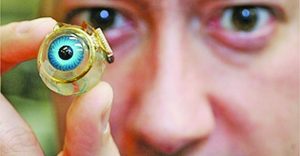A bit about eye lenses
THERE are several options when it comes to lenses to replace your cataract-afflicted bio lens. Don’t get confused. Do some homework and don’t get conned by anyone urging you to buy the most expensive because the most expensive may not be good for you (also depends on all your other health parameters).
These so called intraocular lenses or IOLs come in basically two categories: monofocal (fixed focus) or multifocal (accommodative focus). Lenses may be premium, aspheric or toric (to correct astigmatism) but usually the most popular lenses for cataract surgery are the monofocal IOLs.
The IOLs are medical devices implanted in the eyes to replace natural lens and have been available since 1980s. The monofocal lenses are used in cataract surgery procedure called `phaco’ or phacoemulsification surgery. Monofocal IOLs offer near or mid-distance or distant focus only, while multifocal IOLs accommodate all three and usually advised when both eyes are being operated for cataracts and if prescribed by your ophthalmologist surgeon concerned.
With monofocal IOLs you may usually require glasses for reading or driving. Sometimes one eye may have a short distance monofocal IOL and the other a mid-distance or distance monofocal IOL!
Needless to say all this must depend on what kind of a brief your eye/eyes have vis-à-vis cataracts and the condition of your general health. A friend of mine who was advised multifocal lens had this to say, “I paid over `1.5 lakh but because of my diabetes perhaps I’m having problems focusing post-cataract operation and implantation of multifocal lens…but the doctor says it takes a longer time to adjust to multifocal lenses and eventually my eyes will adjust and I will be more comfortable.”
Is it laser or lazer eye surgery?
 Many use lazer when they mean laser, it’s a common mistake. Laser is actually an acronym for Light Amplification by Stimulated Emission of Radiation but is always written with an s as laser. Laser eye surgery is a medical procedure to correct refractive errors and is commonly used to correct near-sightedness, farsightedness and astigmatism. Laser-based technology has transformed refractive eye surgery making it blade-free. The range of refractive errors which can now be corrected has increased greatly and more complex eye prescriptions can be corrected to a very high-standard. The surgery procedure is quick and over in 10 to 15 minutes. Yes, you can dump your prescription glasses forever!
Many use lazer when they mean laser, it’s a common mistake. Laser is actually an acronym for Light Amplification by Stimulated Emission of Radiation but is always written with an s as laser. Laser eye surgery is a medical procedure to correct refractive errors and is commonly used to correct near-sightedness, farsightedness and astigmatism. Laser-based technology has transformed refractive eye surgery making it blade-free. The range of refractive errors which can now be corrected has increased greatly and more complex eye prescriptions can be corrected to a very high-standard. The surgery procedure is quick and over in 10 to 15 minutes. Yes, you can dump your prescription glasses forever!
GOOD FOR THE EYES!
 Carrots are best for the eyes, vitamins C and E, zinc, lutein, zeaxanthin, omega-3 fatty acids, all play a role in eye health. They can prevent cataracts, clouding of your eye lens. Think oranges and citrus fruit, apricots, all fruit with beta carotene reduce progressive macular degeneration of the eyes. Think spinach, sweet potatoes, butternut squash (pumpkin), kale, green leafy vegetables rich in folic acid, eggs, nuts, beans.
Carrots are best for the eyes, vitamins C and E, zinc, lutein, zeaxanthin, omega-3 fatty acids, all play a role in eye health. They can prevent cataracts, clouding of your eye lens. Think oranges and citrus fruit, apricots, all fruit with beta carotene reduce progressive macular degeneration of the eyes. Think spinach, sweet potatoes, butternut squash (pumpkin), kale, green leafy vegetables rich in folic acid, eggs, nuts, beans.
CATARACTS FACTS
Cataracts don’t just affect the elderly
One of the biggest misconceptions about cataracts is that it is a condition that only affects the elderly. It is true that the majority of the time it affects the elderly but people of all ages can develop cataracts.
Cataracts are the biggest cause of vision loss in the world
Cataracts are the most frequent cause of vision loss in people over the age of 40 and the leading cause of blindness worldwide. There are actually more cases of cataracts worldwide than there are of glaucoma.

Sun exposure can increase your risk of cataracts
Most people know about the dangers that UV rays pose to their skin but did you know that UV rays can be incredibly harmful to your eyes as well? UV rays speed up the breakdown of protein in the lens, which causes cataracts to form. The best way to prevent this is by wearing a hat and protective eyewear.
You can reduce your risk for cataracts
There is no way to completely prevent cataracts from forming but you can reduce your risk by wearing sunglasses, eating a healthy diet, getting exercise, and avoiding tobacco products.
Cataracts develop painlessly
One of the reasons why people don’t often realize they have cataracts until they have experienced significant vision damage is because cataracts develop painlessly. Cataracts are not usually painful until they have developed to the point where they cause extreme sensitivity to light.
